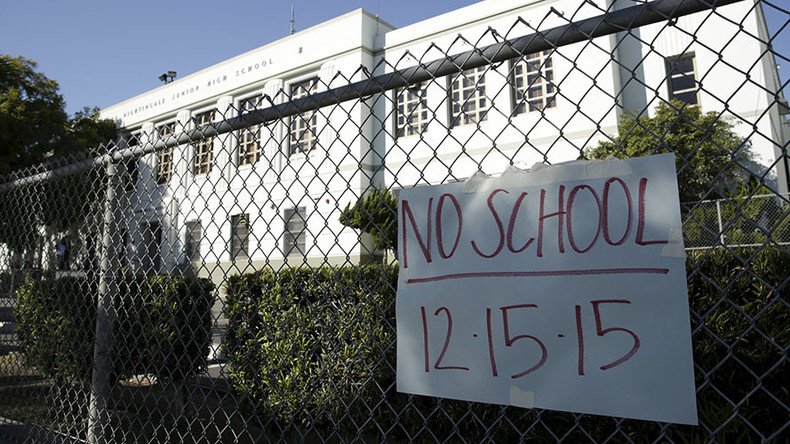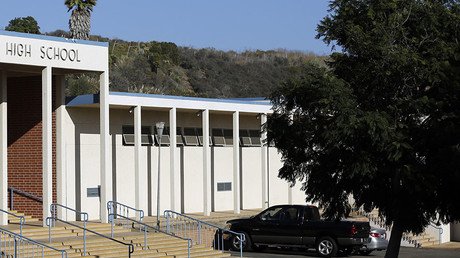‘LA & NY school alerts: Two profoundly different reactions to similar threat’

James Conway, ex-FBI agent and head of Global Intel Strategies said that unlike Los Angeles law enforcement, New York City police are better equipped to analyze different types of threats and determine their credibility.
Los Angeles officials closed 900 schools in the LA Unified School District Tuesday due to an anonymous threat of bomb attacks made via e-mail. Meanwhile, New York’s police decided to dismiss similar e-mails sent at the same time to local public schools, consider them to be a hoax.
James Conway said the State of California is “on edge” following the recent shooting in San Bernardino, and LA school officials nevertheless made their decision “based on the content of that message, which had some pretty violent wording in there, talking about nerve gas and automatic weapons, pressure cookers, and things like that.”
“They just decided to err on the side of caution and not put the kids in school today.”
The ex-FBI agent said New York City officials might be “better equipped” to handle the sort of threats that caused Los Angeles to shut down its school system.
“New York’s Joint Terrorism Task Force, which is a joint effort by New York City police, FBI, law enforcement and the US intelligence community… are better equipped to analyze these types of threats: to look at the IP address, determine from where it came, look at the language.”
He also added that there were some suspicious aspects about the message, including the use of the word “Allah”, which was written with a small ‘a’.
“That kind of took away some of the veracity of it,” he said.
Are terrorist threats issued over e-mail credible?
Dr. Max Abrahms, professor at Northeastern University in Boston said that “what we know so far is that the threat was issued in a form of an e-mail and it went to somebody in a leadership position at the school.”
“Initially it was said that the IP address was based in Germany,” he told RT.
“I have also seen reports more recently saying that the e-mail was sent somewhere closer and made to seem like it was being sent from Germany,” the professor continued.
Abrahams said that the New York City police and the one in Los Angeles received very similar threatening letters at about the same time, but there was an obvious “variation in how those two cities responded.”
“Whereas New York dismissed the e-mail as a hoax, the LA school district was shut down,” he added.
Abrahams also mentioned the time difference between the two cities, which could have resulted in the difference in the sort of response enacted by both cities.
“In New York most of the students were already at school, school had started, whereas in LA it was easier to cancel classes because it was early in the morning,” he told RT.
In general, Abrahms suggests the incident “highlights the difficulty of assessing how seriously we should take a terrorism threat issued over e-mail.”
Closure of schools in LA: overreaction to cyber-terrorism?
Daniel Wagner, CEO of Country Risk Solutions, said the incident demonstrates how much chaos a single act of cyber-terrorism can cause.
“If indeed a single e-mail or perhaps a phone call can elicit this kind of reaction and cause this kind of pandemonium among a large group of people, you are reminded of just how much power and unpredictability cyber terrorism, cyber risk can unfold,” he told RT.
Wagner expressed some disbelief at the number of people impacted by the event.
“I am sort of struck by the number of people that the Los Angeles event impacted. If you take into account the students, as well as the teachers, as well as adult education, it’s nearly a million people.”
As for determining the identity of the perpetrators, the security analyst said that would not be easy.
Finding it a “little bit ironic” that the internet protocol address for this particular threat came from Germany, it doesn’t tell us “who was behind that computer – whether it was a terrorist or someone else.”
Wagner also expressed some bewilderment as to why the Los Angeles School District was the target of the threat “as opposed to a government or military installation,” suggesting that the reason is because “a school district is more of a soft target and is likely to have such a significant reaction.”
Impossible to search every school
Criminal defense attorney and former CIA officer Jack Rice commented that the sheer size of the Los Angeles unified school district – comprising some 900 schools and more than 640,000 children – and the difficulty officials would have in inspecting all those facilities.
“You also have to remember, Los Angeles is spread out – it is not concentrated. The ability to go out and search all of those schools is just about impossible. That is how difficult the job they are facing right now is,” Rice told RT.
“We’re talking about thousands and thousands of buildings,” he added.
Rice then discussed the importance of determining the validity of the threat and if the individuals have the actual means to carry out their threat.
“Let’s take it as a step further," he said. “If there is a threat that was made by e-mail overseas; the question isn’t whether somebody overseas wants to bomb Los Angeles. The question is: ”do they have their logistical capability; do they have the context, do they have the expertise to do what it is what they claim they want to do,” he asked.
The statements, views and opinions expressed in this column are solely those of the author and do not necessarily represent those of RT.













